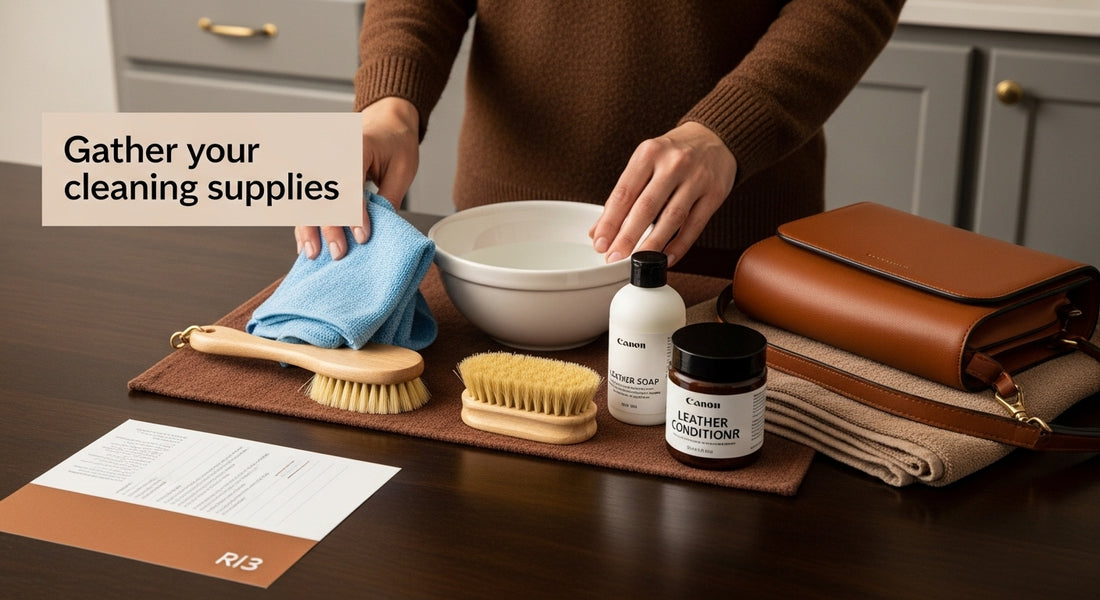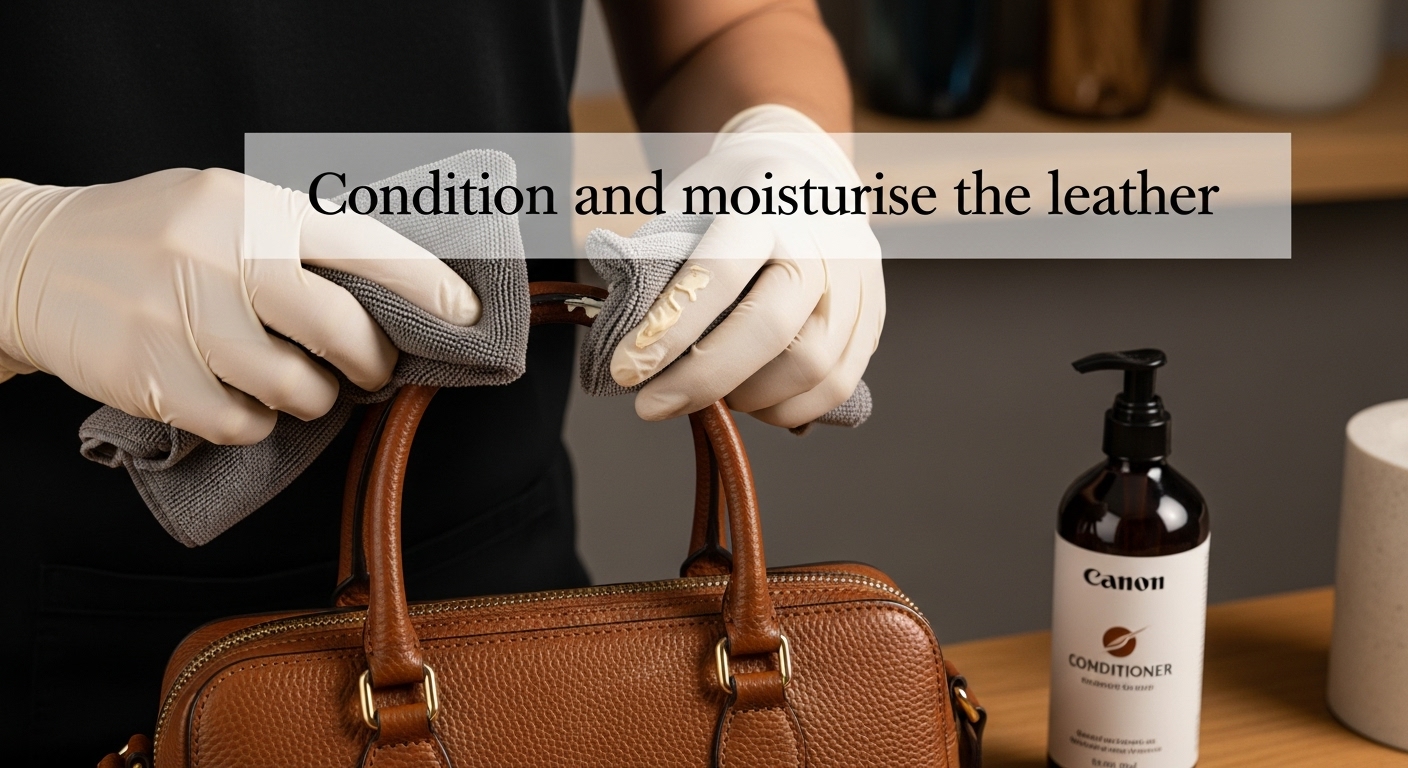
How to Clean Leather Purse: A Step-by-Step Guide
Share
A leather purse adds a touch of understated elegance to any outfit and yet caring for one is far from straightforward. Think a simple wipe-down will do the trick? Not quite. Leather is a delicate material that can be ruined by the wrong routine and even common cleaners can cause permanent damage. Here is the unexpected part. Restoring a leather purse to its original glory often comes down to the tiniest details and the right set of tools, not just the cleaning solution you use.
Table of Contents
- Step 1: Gather Your Cleaning Supplies And Materials
- Step 2: Test A Small Area For Colourfastness
- Step 3: Clean The Exterior With A Suitable Leather Cleaner
- Step 4: Address Stains And Scuffs With Proper Techniques
- Step 5: Condition And Moisturise The Leather
- Step 6: Inspect And Verify The Clean Purse For Quality Finish
Quick Summary
| Key Point | Explanation |
|---|---|
| 1. Gather essential cleaning supplies first. | Assemble soft cloths, mild leather soap, and brushes to protect your leather purse during cleaning. |
| 2. Always perform a colorfastness test. | Test a small, hidden area with your cleaner to check for any adverse reactions before full application. |
| 3. Use gentle cleaning techniques. | Clean with circular motions to avoid damaging the leather, especially around seams and hardware. |
| 4. Address stains with specific techniques. | Different stains require tailored approaches; blot for water stains and absorb grease with powder. |
| 5. Condition leather after cleaning. | Apply a high-quality conditioner to restore moisture, ensuring the leather remains supple and protected. |
Step 1: Gather your cleaning supplies and materials
Cleaning a leather purse requires precision and the right collection of tools. Before diving into the cleaning process, assembling a carefully curated set of supplies will ensure you protect and preserve your cherished accessory. Leather is a delicate material that demands gentle, thoughtful treatment, making preparation crucial to achieving successful results.
Your cleaning toolkit should include several essential items that work harmoniously to restore and maintain your leather purse’s pristine condition. Start by collecting soft, lint-free microfibre cloths which will prevent scratching the leather’s delicate surface. These cloths are far superior to rough paper towels or abrasive materials that could potentially damage your purse.
For cleaning solutions, select a mild leather soap specifically designed for high-quality leather goods. Avoid harsh household cleaners or all-purpose detergents that could strip away the leather’s natural oils and cause permanent damage. A dedicated leather cleaner ensures you’re using a product formulated to clean without compromising the material’s integrity.
Additional essential tools include a soft-bristled brush for gentle debris removal, leather conditioner to replenish moisture after cleaning, and optional items like white vinegar or specialised leather cleaning solutions. Keep a small bowl of lukewarm water nearby for light dampening of your cleaning cloth. Baking soda can also be an excellent emergency spot treatment for minor stains.
Prepare a clean, spacious workspace with good lighting where you can spread out your materials and work methodically. Lay down a soft, clean towel to protect your working surface and provide a gentle area for your leather purse during the cleaning process. Having everything organised and within reach will make the subsequent cleaning steps smoother and more efficient.
Below is a summary table of essential tools and materials required for cleaning a leather purse, along with their specific purpose so you can organise your kit efficiently.
| Item | Specification/Type | Purpose |
|---|---|---|
| Microfibre cloths | Soft, lint-free | Prevent scratching; apply cleaners and conditioner |
| Mild leather soap/cleaner | Specially formulated for leather | Safely cleans without damaging natural oils |
| Soft-bristled brush | Non-abrasive, gentle bristles | Removes debris and dirt from seams and hardware |
| Leather conditioner | High-quality, suitable for purse leather | Restores moisture and suppleness after cleaning |
| White vinegar (optional) | Diluted, if used | Spot treatment for certain stains, if appropriate |
| Baking soda/cornstarch | Finely powdered | Emergency absorption of grease or minor stains |
| Bowl of lukewarm water | Clean, moderate temperature | Lightly dampens cleaning cloths |
| Clean towel/work surface | Soft, clean, large enough | Protects workspace and purse during cleaning |
By meticulously gathering these supplies, you’re setting the foundation for a successful leather purse restoration. Each tool plays a specific role in protecting and revitalising your accessory, ensuring it remains a treasured item in your collection for years to come.
Step 2: Test a small area for colourfastness
Before applying any cleaning solution across your entire leather purse, conducting a colorfastness test is a critical precautionary measure that protects your valuable accessory from potential damage. This preliminary step helps you understand how your specific leather will react to cleaning products, preventing unexpected discolouration or staining that could permanently mar the surface.
Choose an inconspicuous area of the purse for testing, typically an interior seam or a hidden section underneath the bag where any potential colour transfer or reaction will not be immediately visible. The interior bottom or a concealed inside pocket provides an ideal location for this essential assessment. Use a clean, white cloth slightly dampened with your chosen leather cleaning solution to perform the test.
Gently dab the test area using minimal pressure, taking care to observe any immediate changes. Watch carefully for three key indicators: colour bleeding onto the white cloth, noticeable colour fading on the leather surface, or any unusual texture alterations. If the cloth picks up colour or the leather appears altered after application, this signals that your chosen cleaning solution may be too harsh for the specific leather type.
Should no adverse reactions occur during the initial test, wait approximately 15 minutes to confirm there are no delayed colour changes or unexpected chemical interactions.
This waiting period allows you to assess the leather’s full response to the cleaning product. Some leather finishes might seem stable initially but could show subtle degradation over a short time.
If your colorfastness test reveals any concerning changes, discontinue use of the current cleaning solution immediately. Consider seeking professional leather cleaning advice or using a specialised leather cleaner explicitly designed for your purse’s specific leather type. Professional intervention is preferable to risking permanent damage through inappropriate cleaning methods.
Successful completion of this step means you have a clear understanding of how your leather purse will respond to cleaning, providing confidence and safety as you progress to the subsequent cleaning stages. By taking this measured approach, you demonstrate careful stewardship of your cherished leather accessory.
Step 3: Clean the exterior with a suitable leather cleaner
Cleaning the exterior of your leather purse requires a delicate touch and methodical approach to preserve its natural beauty and structural integrity. Leather is a living material that responds best to gentle, purposeful treatment, making your cleaning technique as important as the products you select.
Begin by preparing a soft, clean microfibre cloth and your chosen leather cleaner. Dampen the cloth very slightly with lukewarm water, ensuring it is not wet enough to saturate the leather. Apply a small amount of specialised leather cleaner to the cloth, working the product into the fabric until it creates a light, even coating. The goal is to create a gentle cleaning solution that will lift dirt without overwhelming the leather’s natural properties.
Apply the cleaning solution using circular, sweeping motions that follow the leather’s natural grain. This technique helps distribute the cleaner evenly and prevents creating visible cleaning lines or uneven patches.
Work systematically across the purse’s exterior, paying particular attention to areas that experience more frequent contact such as handles, corners, and bottom surfaces. These regions often accumulate more dirt and require slightly more careful cleaning.
Take extra care around decorative hardware, zippers, and stitching. Use a soft-bristled brush or cotton swab to gently remove accumulated dirt from these intricate areas without applying excessive pressure. The brush should barely touch the surface, using light, precise movements to dislodge any embedded particles without risking damage to the leather or its embellishments.
After thoroughly cleaning the entire exterior, use a separate clean, dry microfibre cloth to remove any remaining moisture or cleaning product. Avoid rubbing aggressively, instead using soft, patting motions that lift away excess liquid without creating friction that could potentially damage the leather’s surface. The leather should look refreshed and clean, with a subtle, natural sheen that indicates proper treatment.
Allow your purse to air dry naturally at room temperature, keeping it away from direct sunlight or heat sources that could cause unexpected shrinkage or colour fading. This final drying phase is crucial in ensuring your leather purse maintains its shape and quality throughout the cleaning process. By following these careful steps, you are not just cleaning your purse, but preserving a cherished accessory with the respect it deserves.
Step 4: Address stains and scuffs with proper techniques
Dealing with stains and scuffs on a leather purse requires precision, patience, and a nuanced understanding of leather’s delicate nature. Different types of stains demand specific treatment approaches, making it crucial to identify the nature of the mark before attempting any removal technique. Your goal is to restore the leather’s pristine appearance without causing additional damage.
For water-based stains, start by gently blotting the area with a clean, dry microfibre cloth. Avoid rubbing, as this can spread the stain and potentially damage the leather’s surface. If the stain remains visible, use a slightly damp cloth with minimal moisture, working from the outside of the stain towards its center to prevent spreading. This technique helps contain the stained area and minimise potential damage to surrounding leather.
Grease or oil-based stains require a different approach. Sprinkle a small amount of cornstarch or talcum powder directly onto the affected area, allowing it to sit for approximately one hour. The powder will naturally absorb the oils, drawing them away from the leather’s surface. After the waiting period, use a soft brush to gently remove the powder, taking care not to press too firmly against the leather. If the stain persists, a specialised leather degreasing product might be necessary.
Scuffs and minor scratches can often be minimised using gentle techniques. For light scuffs, try using a leather conditioner applied with a soft cloth, working in small circular motions. The conditioner can help blend the scratch into the surrounding leather, making it less noticeable. Deeper scratches might require professional intervention, as attempting to repair them without proper expertise could cause more significant damage.
While addressing specific stains, maintain a consistent, gentle approach. Always test any cleaning method on a small, inconspicuous area first to ensure it does not cause discolouration or further damage. Leather is a living material that responds best to careful, thoughtful treatment. If you are uncertain about a particular stain or its removal, consulting a professional leather cleaning service is the safest option.
Successful stain removal should leave your leather purse looking refreshed and renewed, with minimal evidence of the original mark. The key is patience, gentle technique, and a deep respect for the material’s inherent qualities.
This table provides a quick-reference overview of common types of stains and scuffs found on leather purses, their causes, and the corresponding recommended techniques for effective, safe removal as described in the guide.
| Problem | Typical Cause | Recommended Approach |
|---|---|---|
| Water stain | Spilled liquid or rain | Blot with a dry cloth; gently dab with slightly damp cloth if needed |
| Grease/oil stain | Skin oils, food, cosmetics | Sprinkle cornstarch/talcum powder, leave for 1 hour, brush off gently |
| Light scuff/scratch | Surface abrasion, friction | Apply leather conditioner in circular motions with soft cloth |
| Deep scratch or mark | Sharp object, heavy use | Consult a professional cleaner for safe repair |
| General surface dirt | Everyday handling, dust | Clean with mild leather cleaner and microfibre cloth in circular motions |
| Residue on hardware/stitch | Cleaner/product not fully removed | Wipe gently with soft cloth; ensure residue is cleared |
Step 5: Condition and moisturise the leather
Conditioning represents the critical final stage of leather purse maintenance, transforming your cleaning efforts into a comprehensive restoration process. Leather is a natural material that requires regular nourishment to maintain its suppleness, prevent cracking, and preserve its inherent beauty. This step goes beyond mere aesthetic improvement, acting as a protective mechanism that extends your purse’s functional lifespan.
Select a high-quality leather conditioner specifically designed for your purse’s leather type. Professional-grade conditioners typically contain natural oils and proteins that replenish the leather’s moisture content without causing excessive saturation. Begin by ensuring your purse is completely dry from previous cleaning stages, as applying conditioner to damp leather can trap moisture and potentially encourage mould growth.
Apply the conditioner using a clean, soft microfibre cloth, working in gentle, circular motions that follow the leather’s natural grain. Use sparingly and methodically, spreading a thin, even layer across the entire exterior surface. The key is achieving complete coverage without oversaturating the material. Focus on areas that experience more friction or show signs of potential wear, such as handle attachments, corners, and edges.
Allow the conditioner to absorb naturally, giving the leather sufficient time to drink in the nourishing components. Depending on the specific product, this absorption process might take between 15 and 30 minutes. During this period, the leather will gradually integrate the conditioning agents, restoring its natural oils and creating a protective barrier against future environmental stressors.
After the initial absorption, use a clean, dry microfibre cloth to gently buff the leather surface. This final step removes any excess product and helps distribute the conditioner evenly, creating a subtle, natural sheen. The leather should appear refreshed, with a soft, supple texture that indicates successful conditioning.
 Avoid direct sunlight or heat sources during this process, as these can potentially compromise the conditioning treatment.
Avoid direct sunlight or heat sources during this process, as these can potentially compromise the conditioning treatment.
Proper conditioning transforms your leather purse from a mere accessory into a well-maintained, resilient piece that will continue to develop character and elegance with age. By investing time in this meticulous process, you are essentially extending an invitation to your purse to age gracefully, preserving its inherent beauty for years to come.
Step 6: Inspect and verify the clean purse for quality finish
The final stage of leather purse restoration involves a meticulous inspection that transforms your cleaning efforts into a comprehensive quality assurance process. A thorough visual and tactile examination reveals the true success of your restoration, ensuring every aspect of the purse meets the highest standards of care and maintenance.
Begin your inspection under bright, natural lighting that allows you to detect subtle changes in texture, color, and overall finish. Position the purse on a clean, neutral-colored surface that provides maximum contrast, enabling you to identify any imperfections or areas requiring additional attention. Use clean, dry hands to gently feel the leather’s surface, checking for uniform smoothness and consistent texture across different sections.
Focus your examination on several critical areas that often reveal the most about leather restoration quality. Hardware and metal components should appear clean and free from cleaning product residue, with zippers, clasps, and decorative elements maintaining their original luster. Pay particular attention to seams, corners, and edges where dirt and wear typically accumulate most significantly. These areas serve as indicators of your cleaning thoroughness and the leather’s overall condition.
Check the leather’s color and sheen, ensuring the cleaning and conditioning processes have not altered its original appearance. The surface should display a soft, natural radiance without looking overly glossy or artificially treated. Subtle variations in tone are acceptable and often contribute to the leather’s unique character, but dramatic color changes might indicate improper cleaning techniques or unsuitable product selection.
Run your fingers across different sections, assessing the leather’s suppleness and moisture balance. The material should feel soft and responsive, demonstrating that conditioning has successfully restored its natural properties. Stiffness or excessive dryness suggests that further conditioning might be necessary, while an overly greasy feel indicates product over-application.
Finally, examine the purse from multiple angles, rotating it to catch light from different perspectives. This comprehensive approach helps identify any remaining stains, scuffs, or areas requiring additional treatment. Your goal is not perfection, but a thoughtful restoration that preserves the leather’s inherent beauty and character. By investing time in this careful inspection, you transform basic cleaning into an art of leather preservation.
Preserve Your Leather Purse’s Beauty with San Rocco Italia
You have just discovered how to clean and care for your cherished leather purse. Yet, even with the utmost attention, genuine leather needs ongoing support to keep its charm alive. The article touches on delicate surfaces, risks like stains and scuffs, and the value of using the right tools and techniques to protect your accessory. Why risk hard-earned investment or sentimental favourites with ordinary care when the right craftsmanship makes a lasting difference?

At San Rocco Italia, our collection of full-grain leather handbags is handcrafted by skilled Italian artisans who understand what it means to blend durability with timeless elegance. Each piece is designed with materials and methods that respond well to proper care, just as described in your step-by-step guide. Treat yourself to unmatched quality or explore the best way to upgrade your handbag with one of our luxury leather bags. Do not wait for cracks or fading to take away from your style. Visit our boutique today and embrace the confidence that comes with owning a piece built for beauty as well as longevity.
Frequently Asked Questions
How often should I clean my leather purse?
It is recommended to clean your leather purse every 3 to 6 months, depending on usage. Regular maintenance helps prevent dirt buildup and preserves the leather’s appearance.
What type of leather cleaner should I use for my purse?
Use a mild leather soap or a specialised leather cleaner formulated specifically for high-quality leather goods. Avoid harsh household cleaners that can damage the leather.
How can I remove specific stains from my leather purse?
For water-based stains, lightly blot the area with a dry cloth. For grease stains, sprinkle cornstarch or talcum powder, let it sit for an hour, and then gently brush it off. Always test any method on an inconspicuous area first.
Why is conditioning important for my leather purse?
Conditioning restores moisture, prevents cracking, and prolongs the lifespan of your leather purse. It is essential to maintain the leather’s natural suppleness and protect it from environmental stressors.
Recommended
- Understanding Vegetable Tanned Leather Patina: Beauty Unveiled – San Rocco Italia
- Leather Care Complete Set | Natural & Eco-friendly – San Rocco Italia
- Colorless Leather Conditioner Cream | TLCare1 Leather Care – San Rocco Italia
- Understanding Italian Leather Craftsmanship: Timeless Quality – San Rocco Italia


